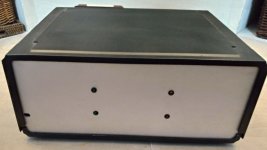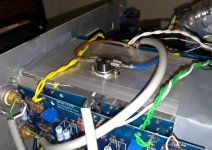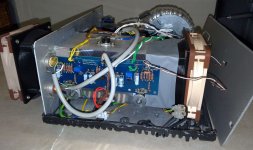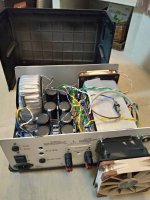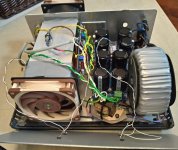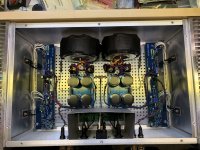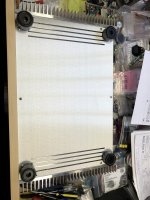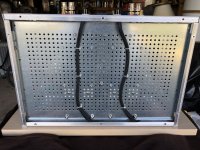Hello all
It's not the prettiest in terms of internal layout, but it's been running without any problems for 7 years now.
500 VA toroid, biased to 1,3 A.
The temperature sensor cuts power to the transformer as soon as the heatsink exceeds 60ºC, the fan remains on, it has independent power.
When the temperature in the room approaches 30ºC, it is necessary to turn on the rear fan....
Best regards
Carlos Barata
It's not the prettiest in terms of internal layout, but it's been running without any problems for 7 years now.
500 VA toroid, biased to 1,3 A.
The temperature sensor cuts power to the transformer as soon as the heatsink exceeds 60ºC, the fan remains on, it has independent power.
When the temperature in the room approaches 30ºC, it is necessary to turn on the rear fan....
Best regards
Carlos Barata
Attachments
I’m in a situation where I built a pair of chassis’ to mimic the 4U/300 “Jack of all Chassis”.
The heatsinks have slightly lower dissipation characteristics…they are 12” X 7” extrusions sourced from Heatsinks USA.
I built a pair of Babelfish J2 in the cases.
I’m already at the radiant limits of the heatsinks capabilities to dissipate heat running about 1A3 of bias. I’m producing 53C at the the top of the heatsinks.
The bias sweet spot for this amp design is about 1A7.
I did an experiment trying some smalll fans pushing air up through the vent slots I created in the bottom of the case.
I’m not getting good results due, in my opinion, to the amp boards being mounted horizontally in the bottom of the cases on the base plate over the slots. It’s all restricting air flow.
No real reduction in temps that I could measure.
I can try directing flow up along the exterior of the heatsink fins…I’m doubtful it will get me to my bias goal.
The other option is pull the cases apart and try mounting fans in the back panel blowing fresh air in directly over the transistors on the heatsinks with a voltage regulator of some type to dial in a balance of noise/cooling.
I didn’t really want to get involved in a complex fan control situation. I had tried a simple thermostatic based switching pcb on a previous amp. The clicking of the relay drove me crazy.
I’m now thinking that perhaps these amp boards need to migrate to a larger case with better dissipation if I want to attain the higher bias setting.
What to do with these cases if that happens?
Are there particular FirstWatt designs that are know to run well at a lower/cooler bias and be more appropriate for these cases?
The heatsinks have slightly lower dissipation characteristics…they are 12” X 7” extrusions sourced from Heatsinks USA.
I built a pair of Babelfish J2 in the cases.
I’m already at the radiant limits of the heatsinks capabilities to dissipate heat running about 1A3 of bias. I’m producing 53C at the the top of the heatsinks.
The bias sweet spot for this amp design is about 1A7.
I did an experiment trying some smalll fans pushing air up through the vent slots I created in the bottom of the case.
I’m not getting good results due, in my opinion, to the amp boards being mounted horizontally in the bottom of the cases on the base plate over the slots. It’s all restricting air flow.
No real reduction in temps that I could measure.
I can try directing flow up along the exterior of the heatsink fins…I’m doubtful it will get me to my bias goal.
The other option is pull the cases apart and try mounting fans in the back panel blowing fresh air in directly over the transistors on the heatsinks with a voltage regulator of some type to dial in a balance of noise/cooling.
I didn’t really want to get involved in a complex fan control situation. I had tried a simple thermostatic based switching pcb on a previous amp. The clicking of the relay drove me crazy.
I’m now thinking that perhaps these amp boards need to migrate to a larger case with better dissipation if I want to attain the higher bias setting.
What to do with these cases if that happens?
Are there particular FirstWatt designs that are know to run well at a lower/cooler bias and be more appropriate for these cases?
Attachments
Is the perforated plate in addition to a bottom plate? Is the perforated plate necessary? What does the bottom plate look like (size and number of holes)?
You could mount everything on the bottom plate, leave a gap between the amp boards and heat sinks, and put in more holes in the bottom plate next to the heat sinks and under the boards. Also mount the boards on longer standoffs to get better air circulation.
I think by improving air flow your fans will make a difference.
You could mount everything on the bottom plate, leave a gap between the amp boards and heat sinks, and put in more holes in the bottom plate next to the heat sinks and under the boards. Also mount the boards on longer standoffs to get better air circulation.
I think by improving air flow your fans will make a difference.
Something about all this moving air has been bugging me. When we set the output bias of our PassDIY amps, we typically let them cook to stable operating temperature, then set the trimmers or resistors to where they need to be. Doesn’t adding a fan after the fact change things such that the operating parameters are no longer the same as when the bias was set? Wouldn’t we have to set the bias again with the fans running? I know that if you just look at the F5 differently, the bias figures change. Same with the ACA Mini. I’m all for cooling things down with quiet fans for longevity and safety, but I think we’d have to set the bias per conditions, active vs. passive cooling. If you all are already doing that, ignore my head scratching. 😆
Chromenuts,
I noticed a significant temp reduction for my M2 clone by mounting a large fan on the underside of the lid pulling air in from the top. Remove the bottom panel leaving the perforated steel mounting plate as your base, this will allow the air to flow through the interior from top to bottom. Then create your ductwork with some cardboard so the air is directed up through the external heat sink fins and out the top. Refer to the posts in this thread of my experiment.
Install feet under the perforated steel plate as this is the bottom of the chassis now.
Good point von Ah,
I think the M2 bias is self adjusted though.
I noticed a significant temp reduction for my M2 clone by mounting a large fan on the underside of the lid pulling air in from the top. Remove the bottom panel leaving the perforated steel mounting plate as your base, this will allow the air to flow through the interior from top to bottom. Then create your ductwork with some cardboard so the air is directed up through the external heat sink fins and out the top. Refer to the posts in this thread of my experiment.
Install feet under the perforated steel plate as this is the bottom of the chassis now.
Good point von Ah,
I think the M2 bias is self adjusted though.
Last edited:
Hi Ben
To answer your question:
The amps are built with a modified Pi Metals 4U X 12 X 19 all aluminum exterior case.
I installed some extra Modushop perforated base plates I had that all the power supply components and amp boards are mounted to. Removing them would require drilling the outer bottom cover and remounting everything.
I thought about modifying the perforated base plate to try and allow more airflow, but the amp boards would still be in the way.
Taller standoffs were under consideration.
This all seems much more involved than using the back panel to mount fans and getting fresh air directly to the transistors.
I’ve attached a pic from the bottom showing the outer case with ventilation slots and also what it looks like from the bottom when the outer cover is removed.
To answer your question:
The amps are built with a modified Pi Metals 4U X 12 X 19 all aluminum exterior case.
I installed some extra Modushop perforated base plates I had that all the power supply components and amp boards are mounted to. Removing them would require drilling the outer bottom cover and remounting everything.
I thought about modifying the perforated base plate to try and allow more airflow, but the amp boards would still be in the way.
Taller standoffs were under consideration.
This all seems much more involved than using the back panel to mount fans and getting fresh air directly to the transistors.
I’ve attached a pic from the bottom showing the outer case with ventilation slots and also what it looks like from the bottom when the outer cover is removed.
Attachments
not enough slot area on bottom plate
base plates - when using 400 deep, Modushop base plate is perfect in size - having properly smaller area than area of case, so natural or forced air is unobstructed
so, moral of the story - now you know why I'm always stressing that 4U/400deep is best (Ok, minimal) size for FW format amps
300deep is ......... simply leading to too much compromises
in short, 4U/400 is proper, either you buy it or make your own - then use it as recipe
base plates - when using 400 deep, Modushop base plate is perfect in size - having properly smaller area than area of case, so natural or forced air is unobstructed
so, moral of the story - now you know why I'm always stressing that 4U/400deep is best (Ok, minimal) size for FW format amps
300deep is ......... simply leading to too much compromises
in short, 4U/400 is proper, either you buy it or make your own - then use it as recipe
Yep, not enough opening area.
And the easiest fix right now is to put a fan on either side of the AC input at the back panel. There appears to be lots of room to mount the fans on the inside. Of course the top panel needs enough openings to vent the hot air. Air can't get in if it can't get out.
And the easiest fix right now is to put a fan on either side of the AC input at the back panel. There appears to be lots of room to mount the fans on the inside. Of course the top panel needs enough openings to vent the hot air. Air can't get in if it can't get out.
first help could be using , for both top and bottom plate, 5-7mm risers
meaning - 5-7mm distancers in between covers and case frame, also that longer screws
it'll directly increase airflow capability on top, while at least somewhat on bottom, counting on necessary 1 or even 2pcs of 12cm vents bellow bottom
I mean - some people like putting fans inside/on the case, but I really prefer having them on the base, Babysitter style
meaning - 5-7mm distancers in between covers and case frame, also that longer screws
it'll directly increase airflow capability on top, while at least somewhat on bottom, counting on necessary 1 or even 2pcs of 12cm vents bellow bottom
I mean - some people like putting fans inside/on the case, but I really prefer having them on the base, Babysitter style
What ZM said. If the fans stay at the bottom, put some big holes in the bottom plate directly over the fans. And raise the perforated plate with longer standoffs if possible to improve air flow.
OK guys…I have some time to think about what I want to try to optimize the cooling in these chassis. I’m away the rest of the week with wifey for a little vacation.
I had thought a babysitter that could be used under any amp was a better investment of my time and effort…but given how these were put together it doesn’t seem realistic.
I’m leaning toward a back panel install because it seems a bit more straight forward, and is what I did with my F2J monoblocks.
Additionally, having the fans on the back panel made them inaudible at low RPM.
I just hope I can get enough air flow. I’m trying some of these:
https://www.amazon.com/Coolerguys-Ultra-Devices-Printers-Microelectronics/dp/B094DRHKJX
I could have gotten the Noctua fans, but the cheapskate in me had to see if they would work out.
I had thought a babysitter that could be used under any amp was a better investment of my time and effort…but given how these were put together it doesn’t seem realistic.
I’m leaning toward a back panel install because it seems a bit more straight forward, and is what I did with my F2J monoblocks.
Additionally, having the fans on the back panel made them inaudible at low RPM.
I just hope I can get enough air flow. I’m trying some of these:
https://www.amazon.com/Coolerguys-Ultra-Devices-Printers-Microelectronics/dp/B094DRHKJX
I could have gotten the Noctua fans, but the cheapskate in me had to see if they would work out.
How about this Noctua?
Ultra Quiet Silent Noctua
Quiet and not too expensive. It's better to buy once.
I use 900rpm 120mm Ultra Quiet Silent Noctua fans in my THF-51S Mu-follower follower amps and they are very quiet.
Ultra Quiet Silent Noctua
Quiet and not too expensive. It's better to buy once.
I use 900rpm 120mm Ultra Quiet Silent Noctua fans in my THF-51S Mu-follower follower amps and they are very quiet.
I know right?…the smaller 40mm ones I found were advertised as 14dB @3500 RPM.
I’m very particular about background noise so I’m hoping I hit the jackpot with these.
If there isn’t enough room on the back panel then I’ll have to go back in a figure out how to open up airflow from the bottom of the case.
I’m very particular about background noise so I’m hoping I hit the jackpot with these.
If there isn’t enough room on the back panel then I’ll have to go back in a figure out how to open up airflow from the bottom of the case.
Plenty of commercial amps use the front panel for fans or vents.
https://www.altomusic.com/crown-xti-4000-power-amplifier-c01#
https://www.altomusic.com/crown-xti-4000-power-amplifier-c01#
My only concern about forced cooling is that you have to depend on the fans functioning properly in order to cool the amp properly. If a fan fails, it may be a good idea to have a temperature switch or something.
On one hand, it would be a great way to save on chassis cost as you could use smaller heatsinks, mount them inside the chassis so they don't have to be black anodized etc. All of the tricks that you see with pro amps. Fans, like the larger Noctua fans, are so quiet that I don't think you would be able to hear a difference between passive and active cooling in your seating position.
E.g. https://www.digikey.no/en/products/filter/temperature-sensors-thermostats-mechanical-industrial/1072
Never had that issue!
Actually, the question is interesting.
We usually allow audio electronics to "warm up" for a while. Most Alephs, tubes, and so on, tend to sound "better" when warmed up for half to a full hour.
So, if added cooling to keep them at, say, no more than 80F, would they not sound as good?
What if we place the amps in a refrigerator?
- Home
- Amplifiers
- Pass Labs
- Forced cooling a class A amp

